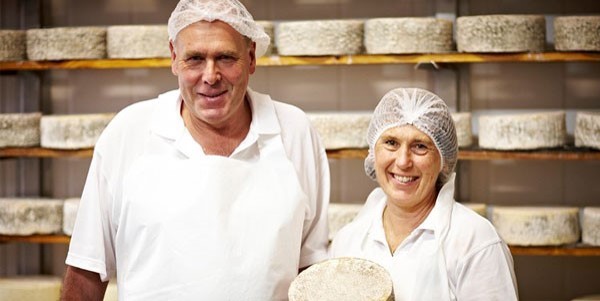Exploring Melbourne Made Cheese: Why Floridia Cheese Is a Must-Try
Exploring Melbourne Made Cheese: Why Floridia Cheese Is a Must-Try
Blog Article
Opening the Keys of Artisanal Cheese Making: A Step-by-Step Do It Yourself Guide
In the realm of cooking workmanship, artisanal cheese making stands as a testament to the delicate balance between custom and innovation. As we begin on this trip to debunk the art of creating exquisite cheeses, we are faced with a tapestry of secrets and abilities waiting to be unwinded.
Choosing the Right Milk
When starting the trip of artisanal cheese making, the choice of milk plays a vital function in identifying the top quality and features of the final product. The kind of milk selected affects the taste, texture, and on the whole profile of the cheese. Raw milk, right from the pet, is chosen by several artisanal cheesemakers due to its distinct blend of enzymes, bacteria, and flavor compounds. Making use of raw milk comes with regulations and dangers, making pasteurized milk a much safer choice for novices.
When selecting milk for cheese production, it is essential to consider the fat material. Greater fat web content in milk can result in a creamier and richer cheese, while reduced fat content may bring about a drier and stronger appearance. Furthermore, the resource of the milk, whether from cows, goats, lamb, or buffalo, adds unique flavors and characteristics to celebrity (Cheese Makers Melbourne). Each sort of milk brings its very own subtleties, permitting a wide range of cheese ranges to be crafted based upon the selected milk. Inevitably, the option of milk is a basic decision that sets the structure for an effective artisanal cheese-making venture.
Culturing and Coagulating
To launch the cheese-making procedure, the important steps of culturing and coagulating have to be thoroughly executed to change milk into curds and whey. The kind of culture made use of can substantially impact the taste, texture, and ripening of the final cheese product.

The timing and temperature control during culturing and coagulation are important elements that affect the final outcome of the cheese. Appropriate implementation of these actions is vital to guarantee the preferred appearance, taste, and consistency of the artisanal cheese being generated.
Draining Pipes and Pushing Curds
After the milk proteins have coagulated and the curds have actually been cut to launch whey, the next important action in artisanal cheese making involves draining pipes and pressing the curds to attain the preferred texture and uniformity of the final cheese product. Draining pipes is the procedure of separating the curds from the whey. This can be done by moving the curds into a cheesecloth-lined bowl-shaped sieve or mold and enabling the whey to drain pipes off normally. The moment for draining pipes can vary read more depending on the kind of cheese being made and the desired dampness content.
Pushing aids eliminate any kind of remaining whey and compacts the curds to form a strong cheese wheel. Correct pushing and draining pipes are important steps that substantially impact the quality and characteristics of the artisanal cheese being generated.
Aging and Flavoring Strategies
Executing precise aging and flavoring methods is critical in improving the deepness and intricacy of artisanal cheeses, elevating their taste accounts to splendid degrees of refinement and elegance. Aging plays an important role in creating the distinct tastes and textures that distinguish artisanal cheeses. During the aging procedure, cheeses are kept in thoroughly regulated environments where aspects such as airflow, temperature, and moisture are adjusted to urge the development of useful mold and mildews and microorganisms. This regulated environment enables the cheese to mature gradually, developing intricate fragrances and abundant tastes.
Seasoning strategies also add considerably to the final preference of artisanal cheeses. Cheesemakers might pick to introduce additional flavors by integrating ingredients such as herbs, seasonings, and even fruits right into celebrity learn this here now during the manufacturing procedure. Furthermore, some cheeses are washed or rubbed with numerous fluids, such as brine or alcohol, to improve their structures and flavors.
Wrapping and Keeping Cheeses

Conclusion
Finally, grasping the art of artisanal cheese making entails thoroughly selecting the right milk, adhering to accurate culturing and coagulating processes, draining pipes and pushing curds properly, and utilizing various check that aging and flavoring strategies. By adhering to these steps faithfully and with focus to information, you can develop your own scrumptious and special cheeses at home. Remember to wrap and store your cheeses properly to make certain optimal taste and structure development. Happy cheese making!
Each type of milk brings its very own subtleties, permitting for a large range of cheese varieties to be crafted based on the chosen milk.After the milk healthy proteins have actually coagulated and the curds have actually been reduced to launch whey, the next vital step in artisanal cheese making entails draining pipes and pushing the curds to attain the desired appearance and consistency of the final cheese product. Many cheeses should be covered in wax paper or cheese paper to permit them to breathe while protecting them from drying out. For cheeses that require to continue aging, such as bloomy rinds or washed skins, ensure they are stored in an amazing setting like a cheese cavern or a fridge set to the ideal temperature. By paying attention to the wrapping and storage of artisanal cheeses, cheese manufacturers and enthusiasts can maintain the stability of these delicacies and fully enjoy their complicated tastes.
Report this page